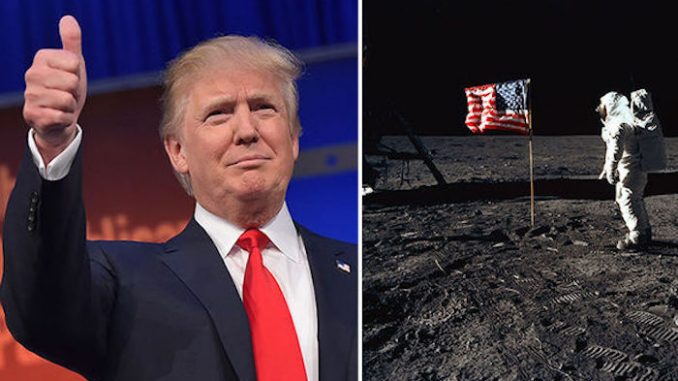
President Trump has ordered NASA to send astronauts to the moon “for the first time” – hinting that he believes the 1969 moon landing was faked.
Trump told the space agency that he wishes to firmly plant the American flag on the moon’s surface and also establish a presence on Mars.

BYPASS THE CENSORS
Sign up to get unfiltered news delivered straight to your inbox.
You can unsubscribe any time. By subscribing you agree to our Terms of Use
Latest Video
“This time, we will not only plant our flag and leave our footprint, we will establish a foundation for an eventual mission to Mars and, perhaps someday, to many worlds beyond,” the President said in a speech.
“The directive I am signing today will refocus America’s space program on human exploration and discovery, It marks a first step in returning American astronauts to the Moon for the first time since 1972, for long-term exploration and use." – @POTUS Trump pic.twitter.com/tNNUz06vEb
— NASA (@NASA) December 11, 2017
NPR.org reports: Standing at the president’s side as he signed “Space Policy Directive 1” on Monday was Apollo 17 astronaut Harrison Schmitt, one of the last two humans to ever walk on the moon, in a mission that took place 45 years ago this week.
Since that time, no human has ventured out beyond low-Earth orbit. NASA doesn’t even have its own space vehicle, having retired the space shuttles in 2011. Americans currently ride up to the International Space Station in Russian capsules, though private space taxis are expected to start ferrying them up as soon as next year.
Tune in as President Trump signs Space Policy Directive – 1: https://t.co/huc4PDVyoC
— The White House 45 Archived (@WhiteHouse45) December 11, 2017
For now, the ultimate goal for human exploration in space remains Mars.
“This time, we will not only plant our flag and leave our footprint, we will establish a foundation for an eventual mission to Mars and, perhaps someday, to many worlds beyond,” Trump said.
Exactly how to get to Mars, however, is subject to debate within the space community.
Many see the moon as the best stepping stone, including Rep. Jim Bridenstine, R-Okla., who is Trump’s pick to head NASA.
The general moon-first approach being taken by the Trump administration was clearly articulated by Vice President Pence at a meeting of the National Space Council in October.
That’s why John Logsdon, a space historian at The George Washington University, says Monday’s announcement is not a surprise. “Now the question is whether the White House will propose and the Congress appropriate the funds needed to turn the words into reality,” Logsdon says.
Indeed, actually getting the funding to achieve presidents’ ambitious space goals is a perennial problem for NASA.
Returning astronauts to the moon had been the plan under President George W. Bush, who called for building a moon base and establishing an extended human presence there. But when a blue-ribbon committee reviewed human spaceflight in 2009, it said there was a mismatch between the scope of the program and the money available to support it: that exploring beyond low-Earth orbit wasn’t going to be viable without billions of dollars more in funding.
What’s more, many worried that NASA would get bogged down in the gray lunar dust and fail to move on toward the Red Planet.
That’s part of why the Obama administration shifted the focus from the moon to a “flexible path” that would target new destinations, such as an asteroid, to get astronauts farther out into deep space.
But the asteroid mission proved more difficult than expected. Eventually, NASA proposed having a robot haul a boulder from an asteroid and put it in orbit around the moon, where astronauts would rendezvous with the space rock. The so-called Asteroid Redirect Mission didn’t receive very enthusiastic reviews from the space community or Congress, and this year it got the ax.
NASA has recently been working on plans for something called the Deep Space Gateway, an outpost in orbit around the moon.
And at the behest of Congress, the space agency has been building a giant new rocket and a deep space capsule. The vehicle is supposed to have its first test flight in 2019, when it will send an uncrewed capsule up to orbit the moon before returning to Earth.
Officials in the Trump administration asked NASA to consider putting humans on that flight, but NASA ultimately decided against it after a review. The first mission with a crew on that NASA spacecraft isn’t supposed to happen until 2022.
The company SpaceX is also constructing a large rocket and has announced that it intends to launch the first private mission to the moon in 2018. SpaceX says it has paying customers for a trip in an automated capsule that wouldn’t land, but would loop around the moon and then return.
SpaceX also has contracts with NASA to bring astronauts up to the International Space Station and is scheduled to start doing that next year as well. The company has already been hauling cargo to and from the station for NASA.
Boeing also has a space transportation system in the works, and its first flight with NASA astronauts on board is planned for 2018.
If those companies’ efforts pan out, their space taxis will be the first vehicles to carry up astronauts from U.S. soil since the retirement of the space shuttles.


